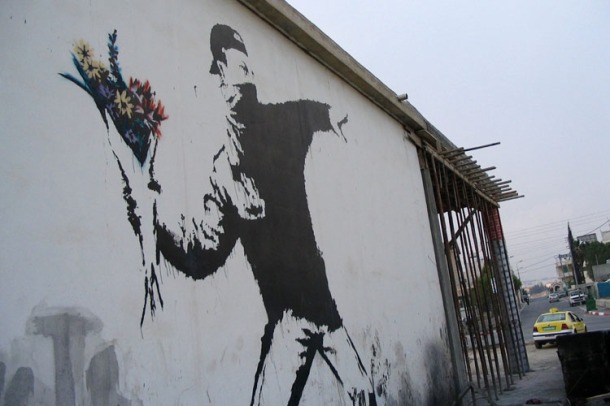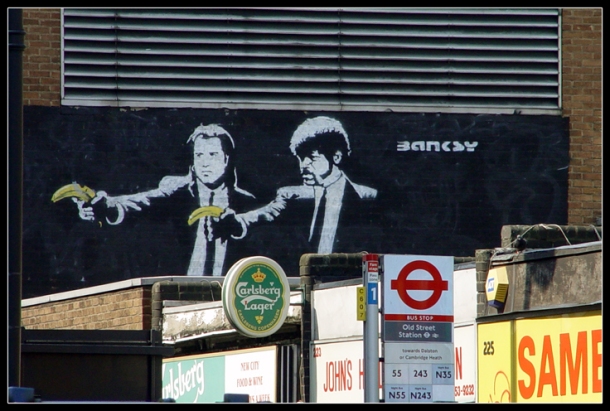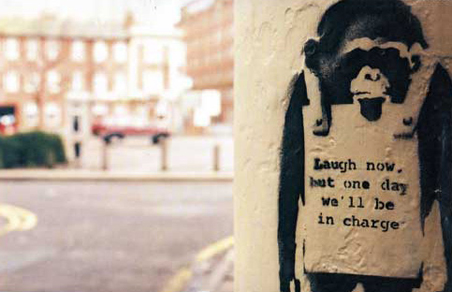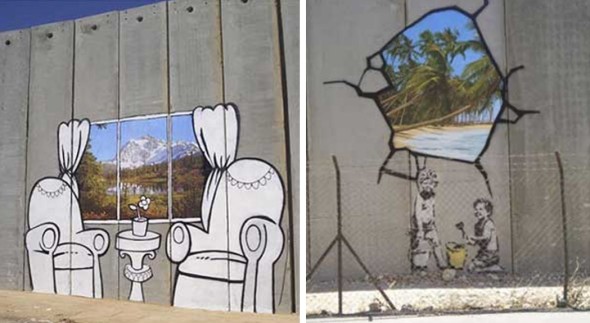In week 4 Mihaly Csikszentmihalyi’s reading, “The Creative Personality”, drove the class into an elaborate discussion/debate over the “personality” traits that he associates with the creative personality. Today I will be summarising a few of the attributes that I believe relate to our group’s creative person, Banksy.
For those of you who missed last week’s monday class, I’ll give a brief summary of what our presentation introduced. Ashleigh and I, who are both studying graphic design, decided on an infamous street artist by the name of Banksy, who’s real identity is hidden from the mainstream media. An artist of very little words, although his strong views on society never shy away from any of his masterpieces, constantly arguing against current laws and raising awareness of the inequality this world has been witnessing over time. Always using his impecable sense of imagination and humour through his work, his law-breaking career, and the risks he wilfully takes to make an impact, has fortunately turned him into a world-wide phenomenon, making millions off his work. But as a graffiti artist, will Banksy check all the right boxes according to Csikzentmihalyi?
Physical energy. The creative person would work long hours, with intense concentration whilst demonstrating a sense of enthusiasm and enjoyment in the process. Not only does Banksy’s career involve the spray painting of a wall, the consideration of placement, size, subject etc. are all very fundamental to how successful the final outcome will be. Therefore, making the stencils and creating an idea, as well as spray painting his images long after dark in complete isolation, is all very time consuming. His results indicate his passion and enjoyment of his career and that’s where, in my opinion, he fits the attribute of having a great deal of physical energy.

Banksy Flower Thrower. Retrieved from: http://www.supergoodtees.com/UserFiles/Image/Banksy_Flower_Thrower.jpg
The next characteristic that I recognise within Banksy’s personality is having the ability to combine playfulness and discipline within their work. Nina Holton, a sculpture artist, states in support of this attribute, “It’s the combination of wonderful wild ideas and then a lot of hard work”. I definitely agree. You need to combine of a lot of hard work and a playful mind, separating your creative ideas from your good ideas, to determine how successful your art work will be. Banksy dedicates an incredible amount of time and effort into just planning and organising what, when and where he is going to paint onto a wall, whilst also allowing his imagination to roam wild and produce the amazing results he does. Although, the combination of playfulness and discipline means that you have to allow the possibility of failure, which isn’t really evident in Banksy’s work.

Pulp Fiction, by Banksy. Retrieved from: http://fc08.deviantart.net/fs5/i/2005/122/2/d/Banksy__Pulp_Fiction_by_brownos.jpg
Similar to the trait above, the next attribute is to alternate between imagination and reality. In class we described this trait as breaking away from the present without losing touch with the past. Banksy always paints denoting common issues in society and uses his imagination to get his message across in a way that will interest locals. His imagination runs wild and results in the common use of rats, monkeys, children, authorities in his work, although he uses the creative ideas that are drawn from his imagination and adjusts them to reality.

Monkey by Banksy. Retrieved from: http://pe.ma/wp-content/uploads/2007/07/monkey.jpg
Banksy is extroverted by communicated with the world in putting his work out for everybody to see, but also introverted, which is his secretive planning and preparation along with his invisibility. I think the title, “graffiti artist”, speaks for itself when we consider the trait of Banksy being a rebellious and independent individual. Graffiti is considered a criminal act and, therefore, rebellion is a trait Banksy obviously has. Not only does he show this level of rebelliousness because of his law-breaking actions but also the messages and subjects he chooses to portray for the world to witness. Independence is very clear throughout his work, which is how his fame began. Banksy wasn’t recognised for tagging his name on every wall he could find, his fame came with his level of originality within the graffiti/street art genre by stencilling and creating images that people would stare at, for the reason that the images were different and powerful. Although Banksy didn’t always start out as a stencilling graffiti artist, he studied traditional graffiti when he was 13/14 and, in time, decided to challenge people’s views on graffiti by changing the way he created his images.
Passionate, yet objective. Being passionate means that you are willing to work on your project for long periods of time and still enjoy what you are doing, although knowing you could be left with room to improve. If you are objective, this means you are dedicated to your work and able to push yourself to improve and get better results. In my opinion, it is definitely obvious that Banksy is both passionate, yet objective about his work and the results he produces. As mentioned above, he puts a lot of effort into producing the images he does and he always works as hard as he can to convey the messages he does. His Palestine journey for example, informs us that he’s objective, by putting his life at risk to have the effect he aimed for from the Palestinians, and the amount of images he pasted and painted on the Palestine wall, just to send his message across, indicates that he is extremely passionate about his work and the possible impact it could make.

Palestine Journey. Retrieved from: http://lh3.ggpht.com/_RzbVbx_mJ-0/SW3770km-7I/AAAAAAAAIH8/fno4k-iX2wQ/banksy.jpg
I believe the 10 attributes introduced in Mihaly Csikszentmihalyi’s reading, “The Creative Personality”, being contradictory, are often evident in a creative person. Notorious street artist, Banksy, was able to check most the boxes of personality traits that were introduced in week 4, and I believe having some or all of these traits definitely have an impact on how creative you are in your specific domain.
REFERENCES
Csikszentmihalyi, M. (1996). The Creative Personality. In Creativity: Flow and the psychology of discovery and invention (pp. 51-76). New York: Harper Collins.
Wall and Piece. Banksy. (2005)